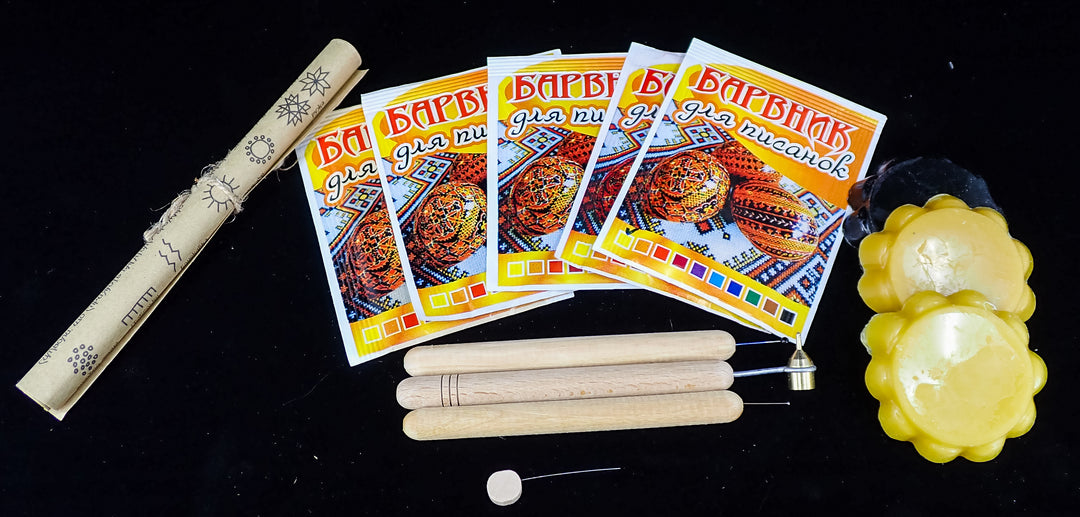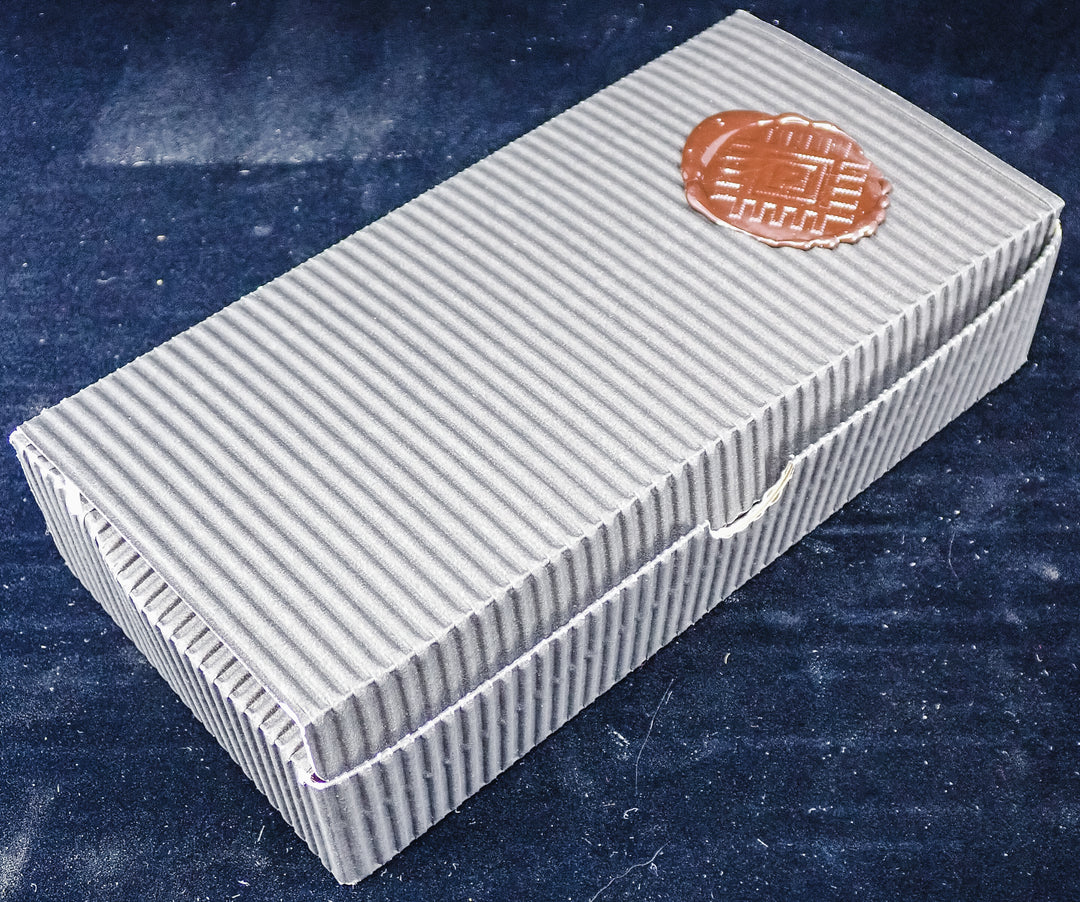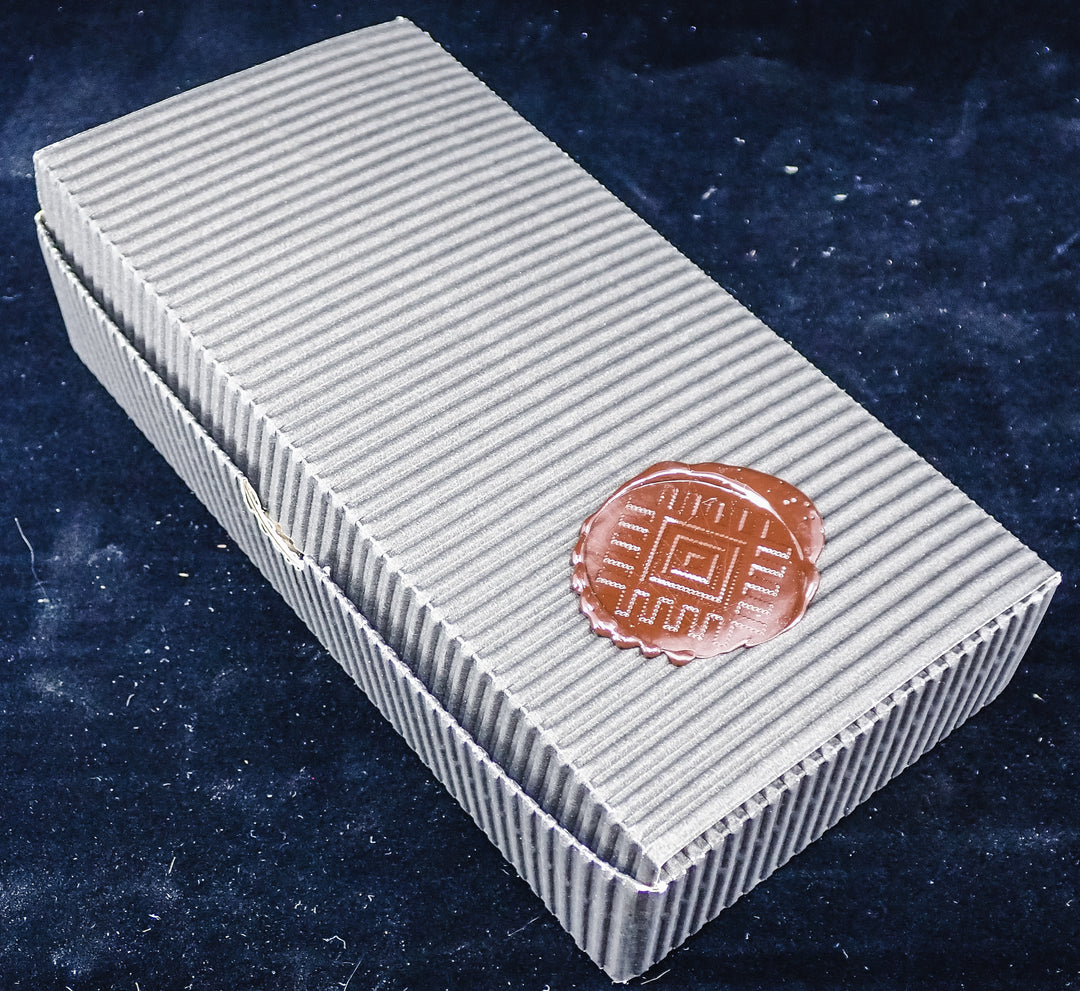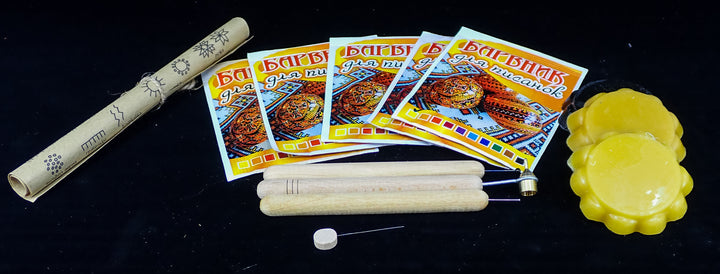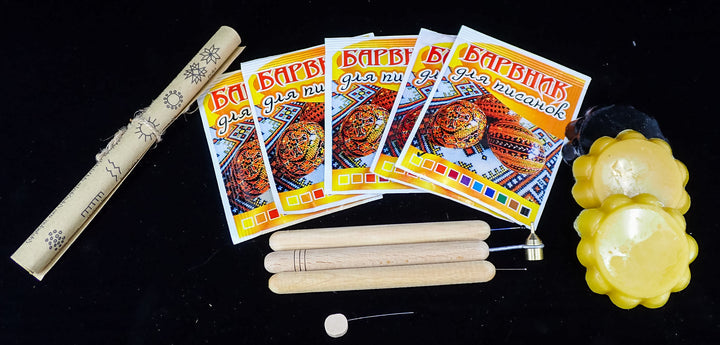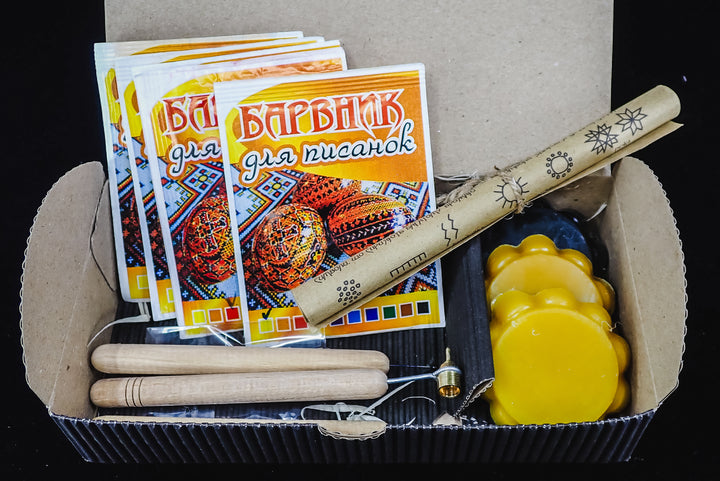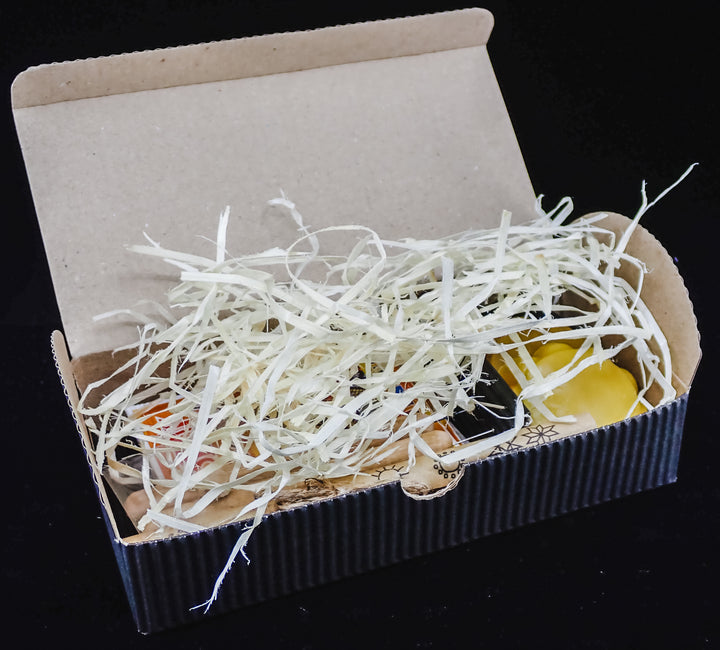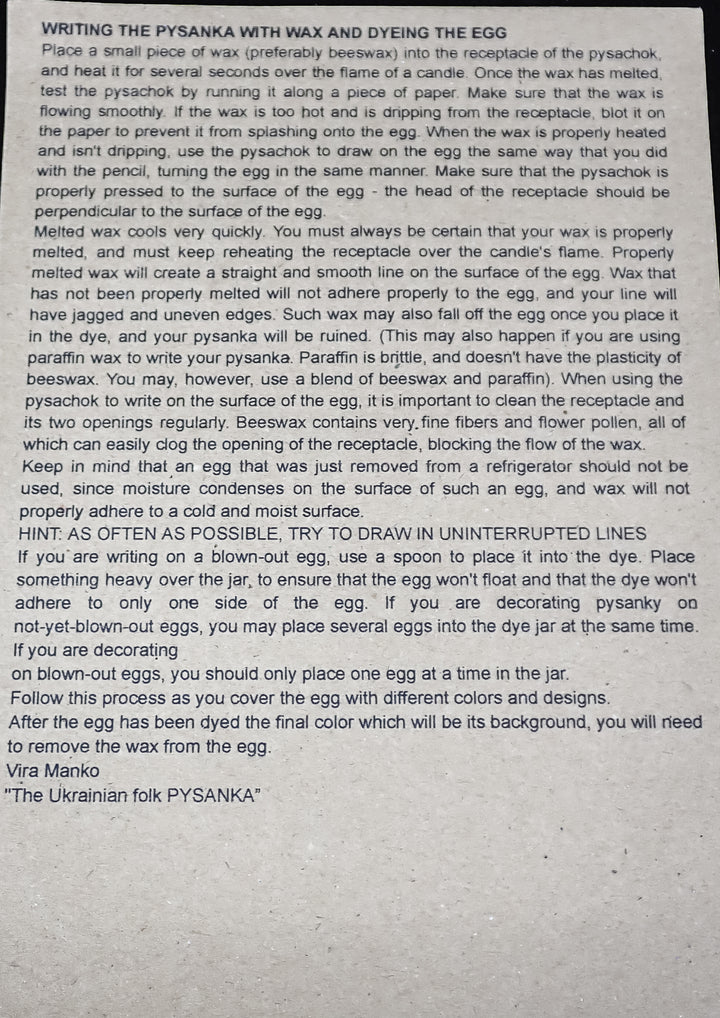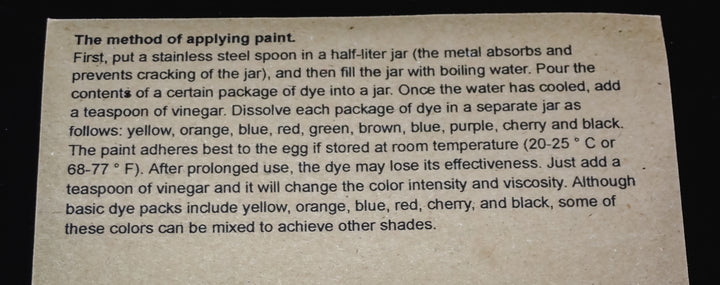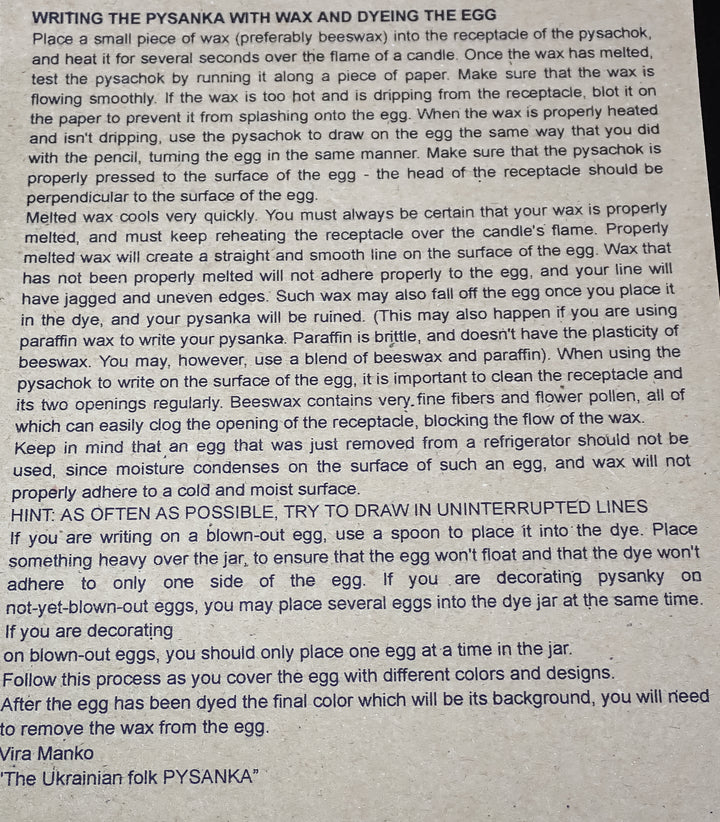UKRAINIAN PYSANKY EASTER EGG ART KIT WITH PENS, WAX AND DYE
LOOK AT THIS!
- In stock, ready to ship
- Inventory on the way
- Fast Shipping From Pennsylvania
- Certified Brand Name : BRAND NAME IN TITLE
Genuine Ukrainian Pysanky Easter Egg Art Kit!
Pysanka is a work of folk art. Their writing techniques were passed down from generation to generation. Each region had its own painting style, flowers, the tree of life, animals, geometric ornaments and many other symbols were written on the egg. Our grandmothers used natural dyes, their method preparation is somewhat more difficult, but times have changed and aniline dyes are now available, which are excellent for work.
The set includes:
- sharpened pen 0.3
- a dart for punching a hole
- pen droplet
- pen, a small droplet
- 100% beeswax black, natural color light and darker (3 pieces each weight 15g)
-5 aniline dyes (yellow, red, blue, green, black)
- scheme-sample of symbols
- branded box
you can also additionally buy pisachok 0.4 and 0.2, for this, go to the link https://ua-souvenirs.com.ua/p681526767-pisachok.html, overfill and additional literature can also be purchased in our store.
We are writing an Easter egg.
1. Materials and tools: chicken egg, vinegar, pen, felt, aniline dyes, wax, candle, paper napkin or a piece of natural canvas.
2. We wipe the egg with a napkin soaked in vinegar and wipe it with a dry cloth. We apply the desired ornament with a pencil. We take a pen and a small amount of wax, put it in a pouring pot and heat it over a candle flame, when the wax has melted, we draw lines on the egg. These lines will remain in this color what was the shell of the egg, white or brown.
3. Dip in yellow paint for 3-5 minutes, it can be a different color of paint, the main thing is to follow the sequence of painting, namely from lighter to darker.
4. Take it out of the yellow paint and dry it, wrapping it in a napkin. It is not recommended to wipe it, just hold the egg in the napkin and all the excess will be removed without additional effort.
5. We take the pen again and continue heating the wax in it to write lines, in our case they will remain yellow.
6. Immerse it in red paint and watch for a few minutes.
7. Remove the egg from the red paint and dry it again in a napkin.
8. With the help of a pen, we cover with hot wax all the lines and areas that should remain red.
9. We dip it in black paint and we begin to imagine what kind of Easter egg we will get.
10. Remove from the paint, wrap the egg with a napkin and wait.
11. Warm up the Easter egg from the side in a high candle flame until the wax starts to melt.
12. Carefully remove the melted wax with a paper napkin - and here we are, our work of art is ready.
Recommendation for beginners
- keep the egg in a warm room before starting work. If the egg is from the refrigerator, it will be more difficult for you to draw lines
- to make the hole in the egg neat, take the felt and gently twist it. After that, inject air into the hole made with a syringe, hold the egg over the vessel and blow out everything that is there. The main thing is to inject air little by little so that the egg does not split due to the pressure.
Beautiful colors are applied to the egg using melted wax and applied with a pen. Since they are handmade each individual egg is different, with different styles. With this listing you will receive one pysanky Easter egg, but the style will vary for each order shipped. You will receive ONE egg similar to what you see in the numerous photographs.
The Ukrainian name for a wax-resist type egg, pysanka, comes from the verb pysaty (писати), meaning "to write", as the designs are written onto the egg with beeswax, not painted on.
No actual pysanky have been found from Ukraine's prehistoric periods, as eggshells do not preserve well. Cultic ceramic eggs have been discovered in excavations near the village of Luka Vrublivets'ka, during excavations of a Trypillian site (5th to 3rd millennium BC). These eggs were ornamented and in the form of торохкальці (torokhkal'tsi; rattles containing a small stone with which to scare evil spirits away).[13]
Similarly, no actual pysanky from the Kyivan Rus' period exist, but stone, clay and bone versions exist and have been excavated in many sites throughout Ukraine. Most common are ceramic eggs decorated with a horsetail plant (сосонка sosonka) pattern in yellow and bright green against a dark background. More than 70 such eggs have been excavated throughout Ukraine, many of them from graves of children and adults. They are thought to be representations of real decorated eggs.
These ceramic eggs were common in Kyivan Rus' and had a characteristic style. They were slightly smaller than life size (2.5 by 4 cm, or 1 by 1.6 inches) and were created from reddish pink clays by the spiral method. The majolica glazed eggs had a brown, green or yellow background and showed interwoven yellow and green stripes. The eggs were made in large cities like Kyiv and Chernihiv, which had workshops that produced clay tile and bricks; these tiles (and pysanky) were not only used locally but were exported to Poland and to several Scandinavian and Baltic countries.[14]
The oldest "real" pysanka was excavated in Lviv in 2013[15] and was found in a rainwater collection system that dates to the 15th or 16th century. The pysanka was written on a goose egg, which was discovered largely intact, and the design is that of a wave pattern. The second oldest known pysanka was excavated in Baturyn in 2008 and dates to the end of the 17th century. Baturyn was Hetman Ivan Mazepa's capital, and it was razed in 1708 by the armies of Peter I. A complete (but crushed) pysanka was discovered, a chicken egg shell with geometric designs against a blue-gray background.[16]
The practice of pysankarstvo was widespread throughout Ukrainian ethnographic lands. They were written in every corner of Ukraine, with traditional folk designs being documented by ethnographers well into the late 19th century in every region of Ukraine. This included those Ukrainians resettled within the Russian empire, and into nearby Slavic countries.
In the mid-19th century, as the modern era unfolded, a shift began in the function of the pysanka, from being a ritual object to that of being a decorative one. Pysankarky (women who wrote pysanky) in the Carpathian mountains (mostly Hutsuls, but Bukovinian Ukrainians and Pokuttians as well) began mass producing pysanky and taking them to nearby towns to sell at Easter. This practice proved profitable, and Ukrainian pysanky began to appear in markets throughout western Ukraine and the rest of the Austro-Hungarian Empire, including major cities like Vienna and Budapest.
In modern times, the art of pysankarstvo was carried abroad by Ukrainian emigrants to North and South America, western Europe, and Australia, where the custom took hold; the practice was concurrently suppressed[failed verification] in Ukraine by the Soviet regime, where it was considered a religious practice nearly forgotten.[17] Museum collections were destroyed both by war and by Soviet cadres.[17] Small areas of folk pysankarstvo survived in Ukraine, in the Cherkasy region and in Northern Bukovina, Hutsulshchyna and Pokuttia, as well as among the Lemkos in neighboring Poland and Slovakia.
Since Ukrainian Independence in 1991, there has been a rebirth of this folk art in its homeland, including a renewal of interest in the preservation of traditional designs and research into its symbolism and history. The Russian invasion of Ukraine in 2022 sparked increased interest in pysankarstvo, both in Ukraine, where patriotic motifs have become more common, and abroad, where interest in Ukrainian culture has dramatically increased.



